Family: Diprionidae
Family common name: coniferconifer:
a usually evergreen tree characterized by reproductive cones; e.g., pine, fir, spruce, larch, etc.
sawflies
Subfamily: Diprioninae
Genus: Neodiprion Rohwer, 1918
Subgenera: none
The Diprionidae are known as the coniferconifer:
a usually evergreen tree characterized by reproductive cones; e.g., pine, fir, spruce, larch, etc.
sawflies, though they are not the only family to use coniferconifer:
a usually evergreen tree characterized by reproductive cones; e.g., pine, fir, spruce, larch, etc.
trees as host (others include Siricidae, Pamphiliidae, Xyelidae, some genera of Tenthredinidae). Many are destructive pests as larvaelarva:
the immature stage of holometabolous insects
 , and so their biology has been more extensively studied than some other groups. Diprionids have stout bodies and distinctive antennal characteristics that make adults easy to recognize (Furniss and Carolin 1977Furniss and Carolin 1977:
, and so their biology has been more extensively studied than some other groups. Diprionids have stout bodies and distinctive antennal characteristics that make adults easy to recognize (Furniss and Carolin 1977Furniss and Carolin 1977:
Furniss RL and Carolin VM. 1977. Western forest insects. United States Deptartment of Agriculture Forest Service Miscellaneous Publication 1339: 1-655.).
Neodiprion is widespread and fairly common in coniferconifer:
a usually evergreen tree characterized by reproductive cones; e.g., pine, fir, spruce, larch, etc.
tree-growing regions. Adults are about 7.5–10 mm in length and are generally red or reddish-brown in color. Several species can be destructive defoliators (Ciesla and Smith 2011Ciesla and Smith 2011:
Ciesla WM and Smith DR. 2011. Diprionid sawflies on lodgepole and ponderosa pines. USDA Forest, Insect, and Disease Leaflet 179: 1-12.).
There are 53 described species worldwide. Richness is highest in North America, where all but six species occur (Taeger et al. 2010Taeger et al. 2010:
Taeger A, Blank SM, and Liston AD. 2010. World Catalog of Symphyta (Hymenoptera). Zootaxa 2580: 1-1064.).
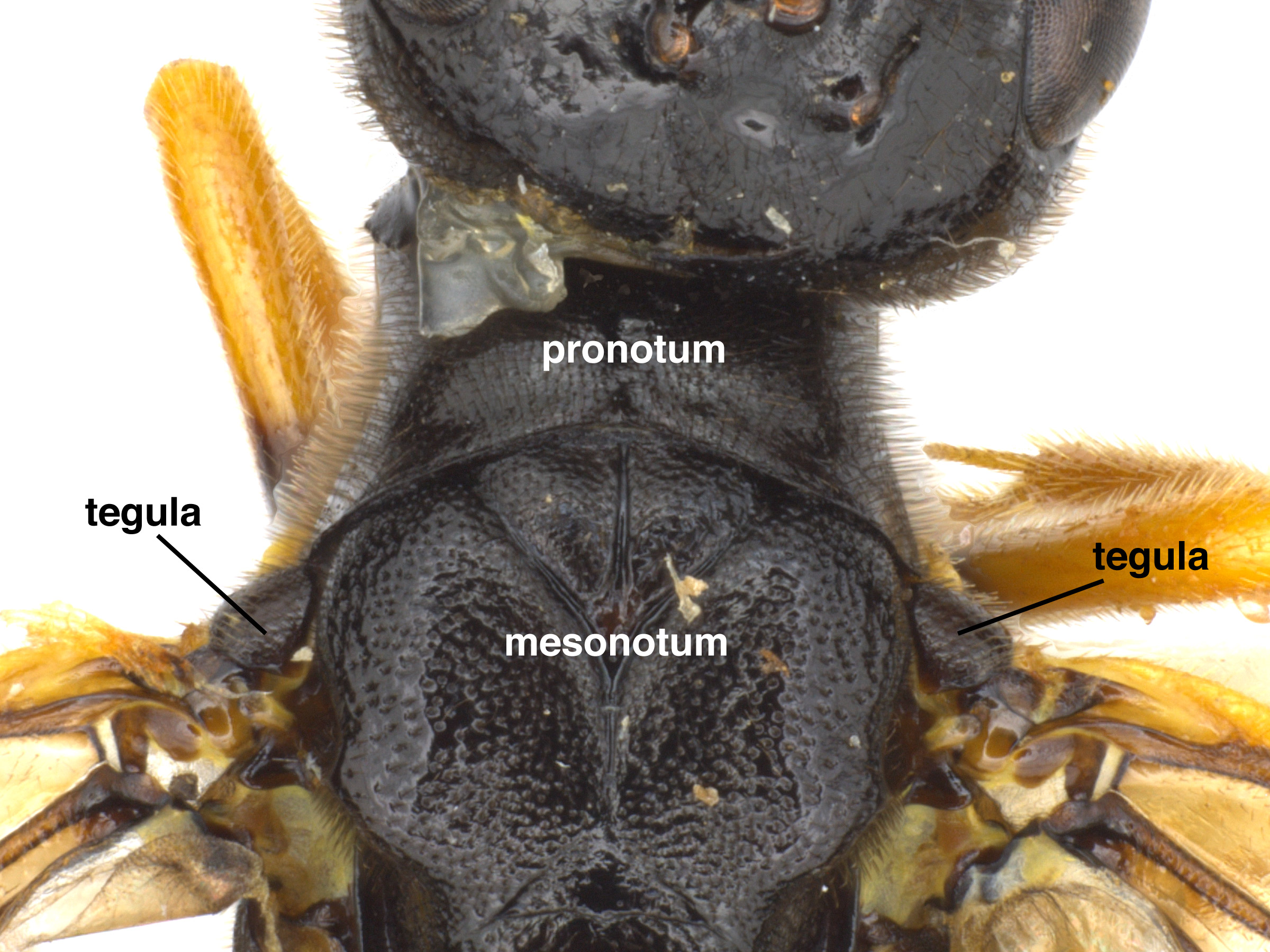 strongly constricted medially, as seen from above (Goulet 1992Goulet 1992:
strongly constricted medially, as seen from above (Goulet 1992Goulet 1992: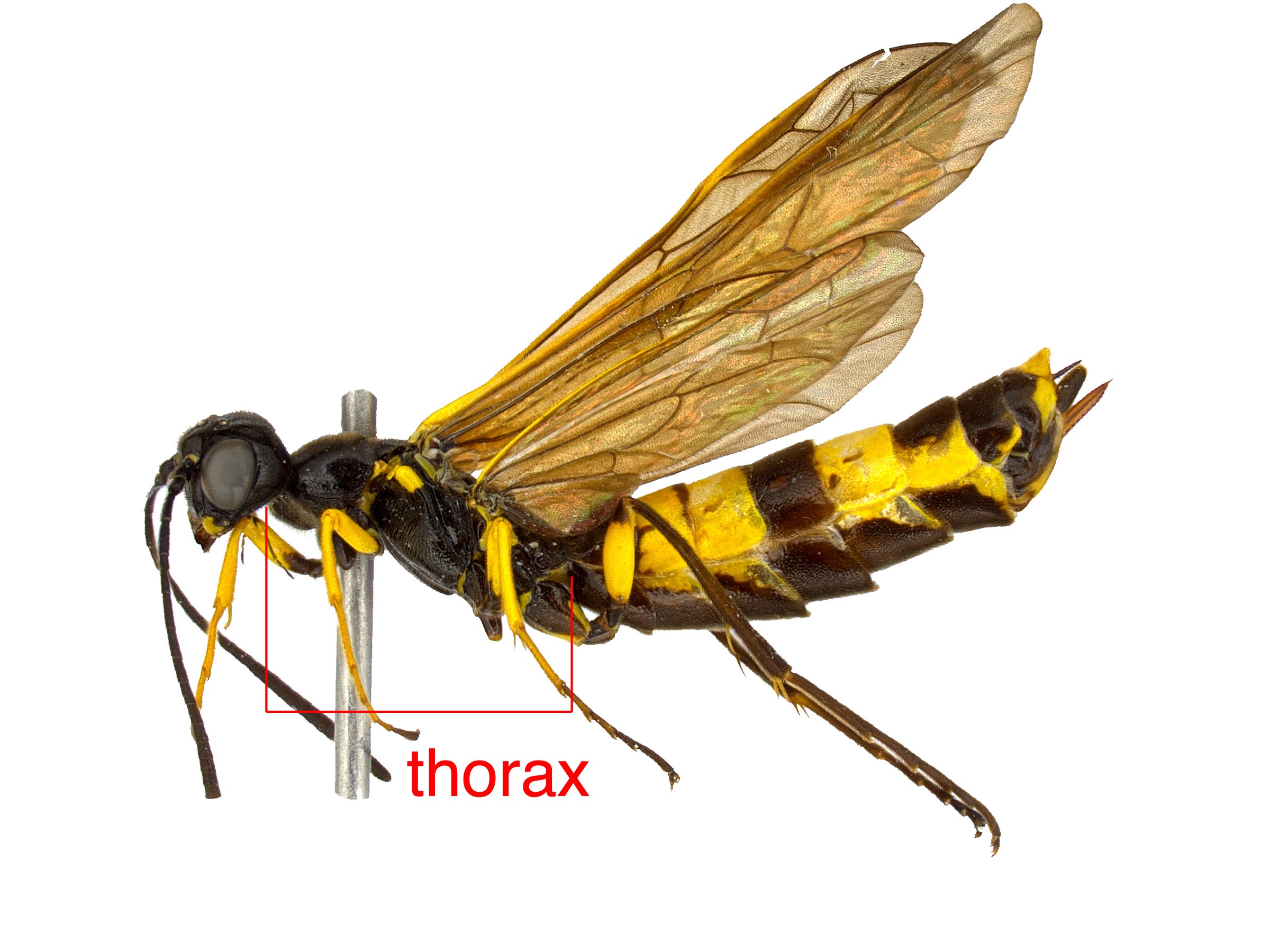 , no distinct “neck” (Goulet 1992Goulet 1992:
, no distinct “neck” (Goulet 1992Goulet 1992: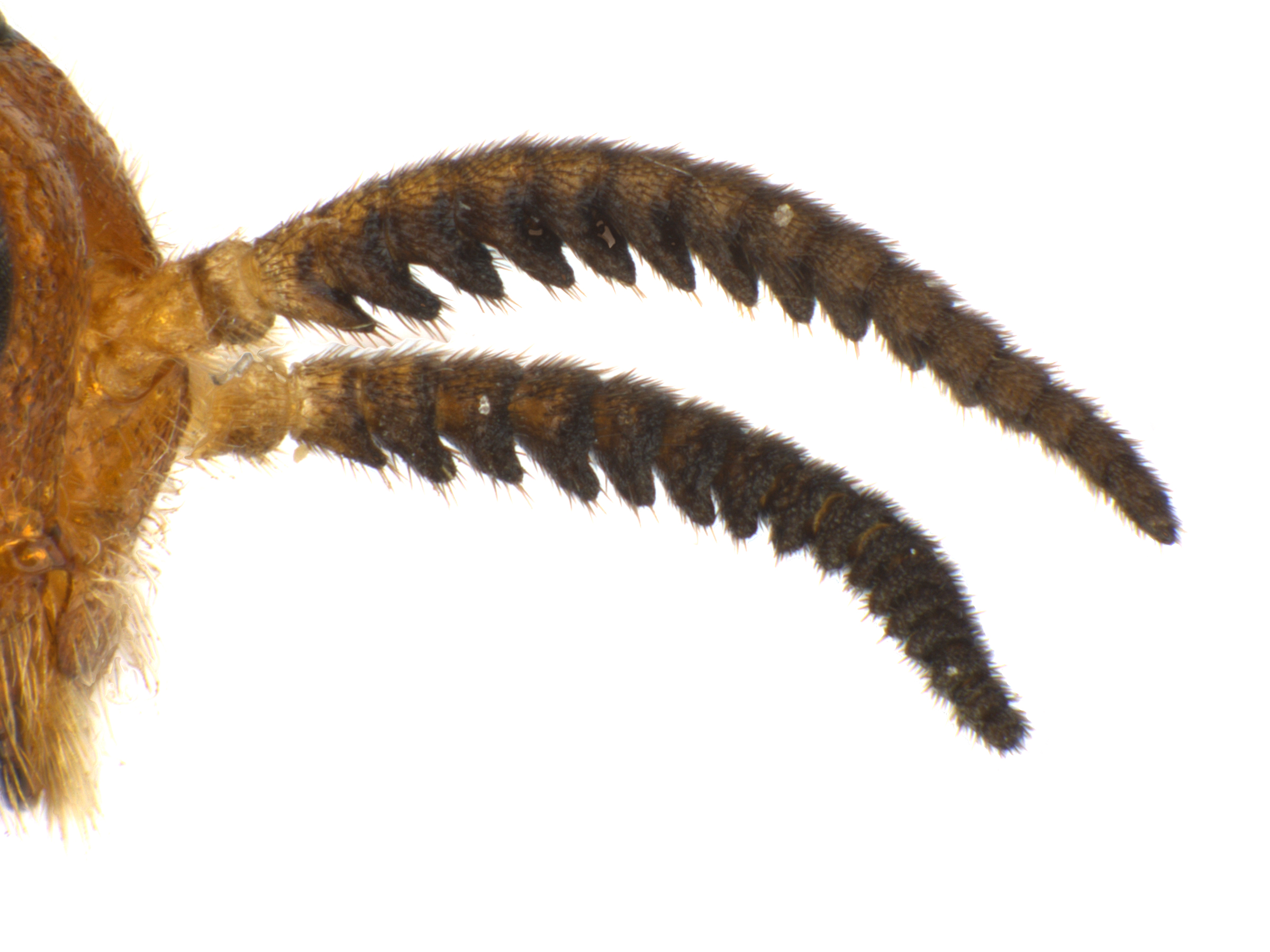 in females, bipectinatebipectinate:
in females, bipectinatebipectinate: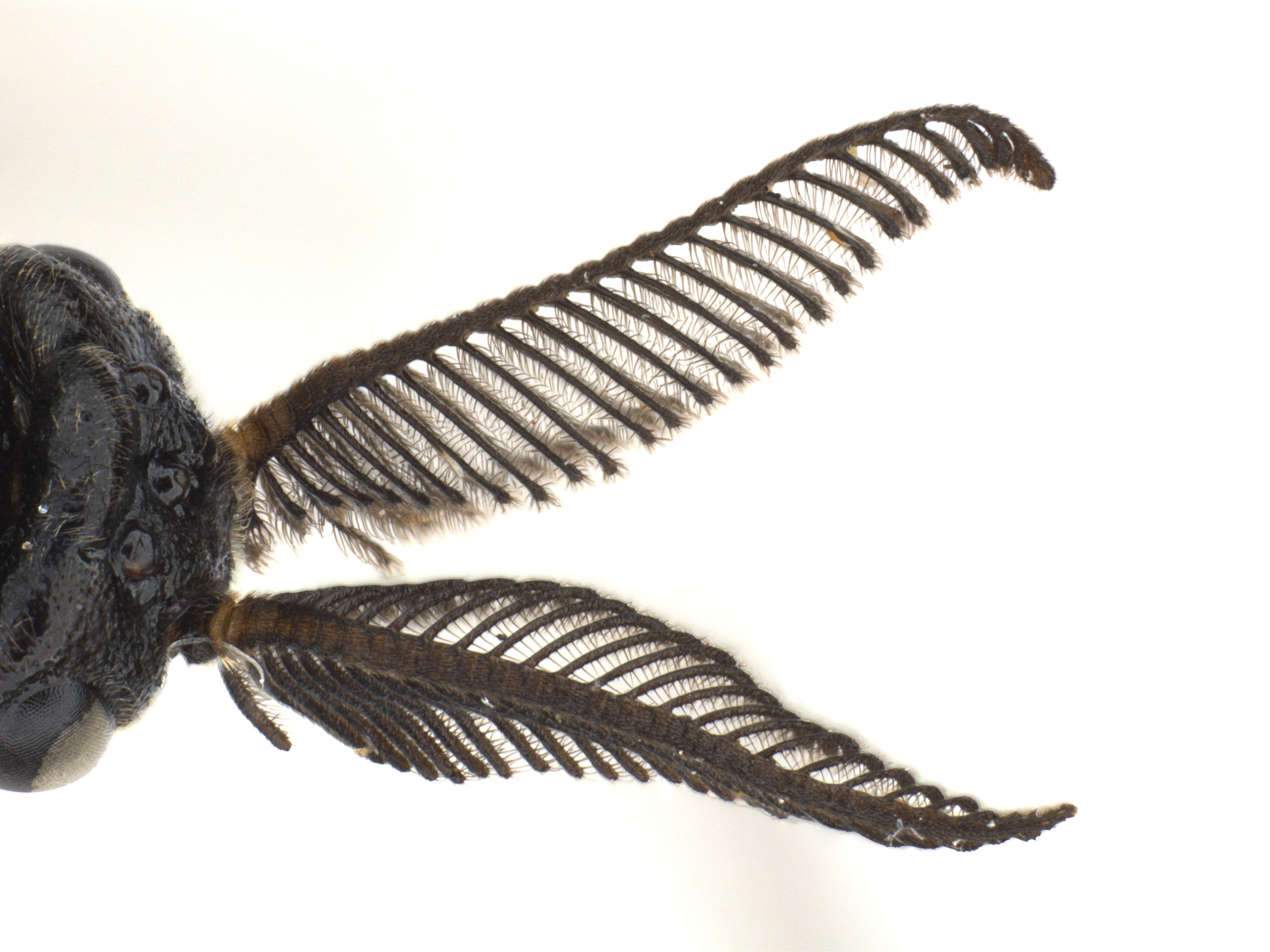 in males (Goulet 1992Goulet 1992:
in males (Goulet 1992Goulet 1992: 1A and 2A of fore wingfore wing:
1A and 2A of fore wingfore wing: connected by a crossveincrossvein:
connected by a crossveincrossvein: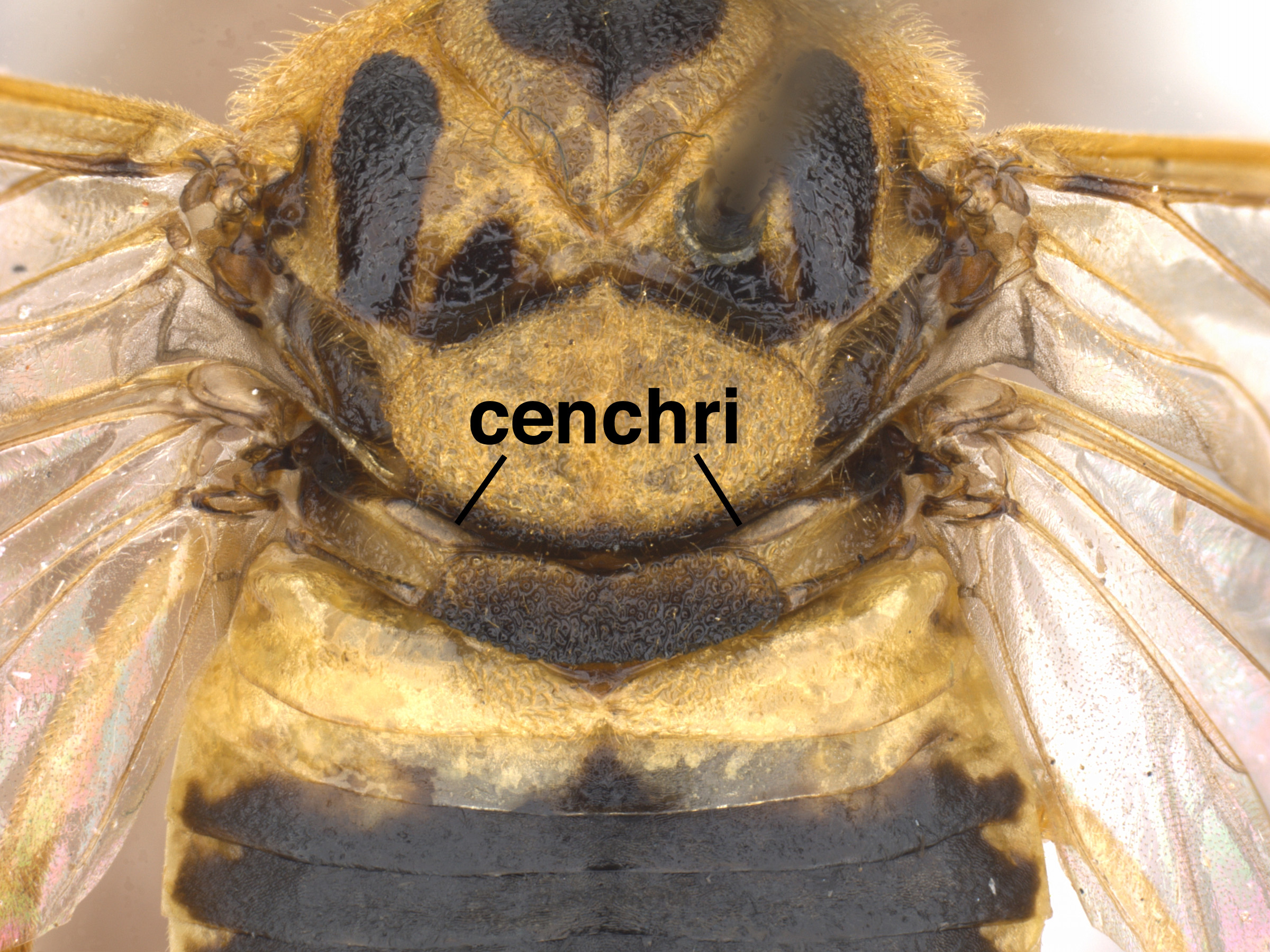 greater than distance between cenchricenchrus:
greater than distance between cenchricenchrus: (Goulet 1992Goulet 1992:
(Goulet 1992Goulet 1992: ; length of metascutellummetascutellum:
; length of metascutellummetascutellum: shorter than width of cenchruscenchrus:
shorter than width of cenchruscenchrus: (Goulet 1992Goulet 1992:
(Goulet 1992Goulet 1992: 1A of hind winghind wing:
1A of hind winghind wing: about as wide as cellcell:
about as wide as cellcell: A (Goulet 1992Goulet 1992:
A (Goulet 1992Goulet 1992:Diprionidae are most easily recognized by the distinctive antennaeantenna:
the sensory organ emerging from the front of the head, usually between the compound eyes and above the clypeus; includes the flagellum, scape and pedicel
 of both sexes, but also are characterized by small, stout bodies. Neodiprion is similar to Gilpinia, but the latter has notably large cenchricenchrus:
of both sexes, but also are characterized by small, stout bodies. Neodiprion is similar to Gilpinia, but the latter has notably large cenchricenchrus:
a sclerotized eliptical lobe on the metascutum used to provide friction with underside of wings to hold them in place on the dorsum of the body while in rest
 , a small mesoscutellummesoscutellum:
, a small mesoscutellummesoscutellum:
the anterior section of the scutellum
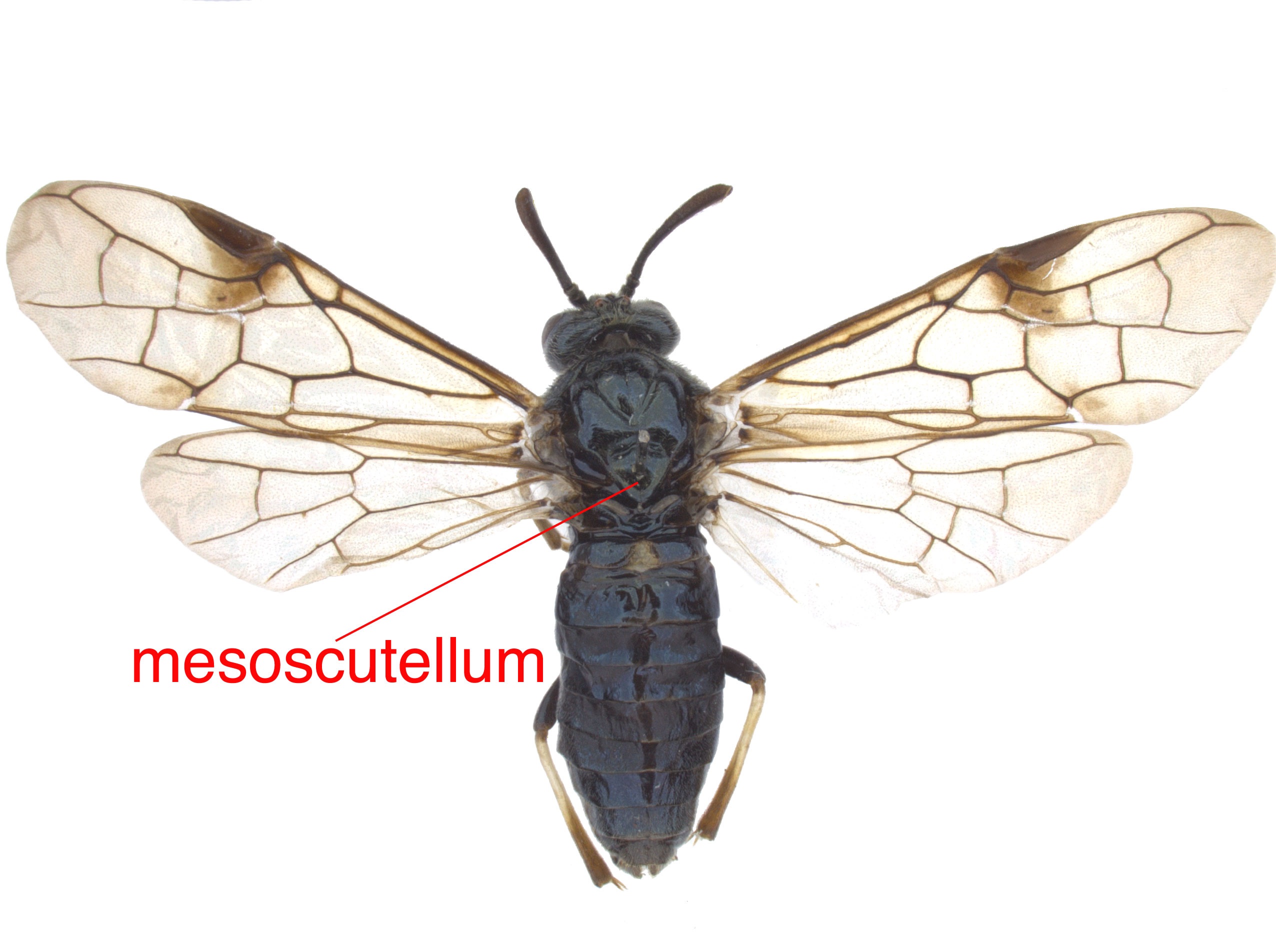 , and a distinct anterioranterior:
, and a distinct anterioranterior:
of or towards the front or head
margin of the mesoscutellummesoscutellum:
the anterior section of the scutellum
 (Smith 1971bSmith 1971b:
(Smith 1971bSmith 1971b:
Smith DR. 1971b. The genus Zadiprion Rohwer (Hymenoptera: Diprionidae). Proceedngs of the Entomological Society of Washington 73 (2): 187-197., Goulet 1992Goulet 1992:
Goulet H. 1992. The genera and subgenera of the sawflies of Canada and Alaska: Hymenoptera. Symphyta. The insects and arachnids of Canada. Part 20. Agriculture Canada Publication.).
Defoliating Neodiprion species described from China are recorded feeding on species of pines that are not commonly grown in North America, but are occasionally used as ornamental plants: Pinus armandii and P. yunnanensis (Li et al. 2012Li et al. 2012:
Li T, Sheng ML, and Sun SP. 2012. Species of the genus Lamachus Forster (Hymenoptera, Ichneumonidae) parasitizing diprionid sawflies (Hymenoptera, Diprionidae) with descriptions of the two new species and a key to Chinese species. ZooKeys 249: 37-49. https://doi.org/10.3897/zookeys.249.4069).
Larvae in North America feed on several species of Pinus (pine), Picea (spruce), Tsuga (hemlock), Pseudotsuga (Douglas fir), and Abies (fir) of the Pinaceae (Smith 1974bSmith 1974b:
Smith DR. 1974b. Conifer sawflies, Diprionidae: Key to North American genera, checklist of world species, and a new species from Mexico (Hymenoptera). Proceedings of the Entomological Society of Washington 76: 409-418.). Common hosts include Pinus ponderosa (ponderosa pine), Pinus resinosa (red pine), and Pinus contorta (lodgepole pine) (Ciesla and Smith 2011Ciesla and Smith 2011:
Ciesla WM and Smith DR. 2011. Diprionid sawflies on lodgepole and ponderosa pines. USDA Forest, Insect, and Disease Leaflet 179: 1-12.).
Neodiprion females oviposit into slits cut longitudinally along the needle. After hatching, larvaelarva:
the immature stage of holometabolous insects
 feed gregariously from the tip of the needle to the basebase:
feed gregariously from the tip of the needle to the basebase:
the beginning or most proximal area of any structure
. As they mature, larvaelarva:
the immature stage of holometabolous insects
 will separate from one another and feed singly in later instars. LarvaeLarva:
will separate from one another and feed singly in later instars. LarvaeLarva:
the immature stage of holometabolous insects
 prefer to feed on older needles and transfer to new growth only after majority of the old growth has been eaten. At maturity, the larvalarva:
prefer to feed on older needles and transfer to new growth only after majority of the old growth has been eaten. At maturity, the larvalarva:
the immature stage of holometabolous insects
 falls to the ground and builds a cocoon in the leaf litter. Depending on the generation, they will pupate or overwinter as a prepupaprepupa:
falls to the ground and builds a cocoon in the leaf litter. Depending on the generation, they will pupate or overwinter as a prepupaprepupa:
the active, non-feeding life stage in which the larva prepares to enter the pupal stage
and eclose in the spring. Some Neodiprion species overwinter in the egg stage and hatch in the spring (Ciesla and Smith 2011Ciesla and Smith 2011:
Ciesla WM and Smith DR. 2011. Diprionid sawflies on lodgepole and ponderosa pines. USDA Forest, Insect, and Disease Leaflet 179: 1-12.).
Larvae of Neodiprion have some uncommon defensive strategies. When disturbed, the larvaelarva:
the immature stage of holometabolous insects
 rear their heads and front portion of the body, moving up and down in unison to surprise or confuse predators. LarvaeLarva:
rear their heads and front portion of the body, moving up and down in unison to surprise or confuse predators. LarvaeLarva:
the immature stage of holometabolous insects
 also sometimes will deposit regurgitated pine resin onto the body of a predator or parasite (Ciesla and Smith 2011Ciesla and Smith 2011:
also sometimes will deposit regurgitated pine resin onto the body of a predator or parasite (Ciesla and Smith 2011Ciesla and Smith 2011:
Ciesla WM and Smith DR. 2011. Diprionid sawflies on lodgepole and ponderosa pines. USDA Forest, Insect, and Disease Leaflet 179: 1-12.).
Many Neodiprion species are economic pests, and outbreaks of some species in pine stands have historically caused significant damage. Coniferousconiferous:
describing a conifer
trees do not regrow foliage every year, so heavy defoliation, especially in combination with other stress, can lead to mortality (Furniss and Carolin 1977Furniss and Carolin 1977:
Furniss RL and Carolin VM. 1977. Western forest insects. United States Deptartment of Agriculture Forest Service Miscellaneous Publication 1339: 1-655., Ciesla and Smith 2011Ciesla and Smith 2011:
Ciesla WM and Smith DR. 2011. Diprionid sawflies on lodgepole and ponderosa pines. USDA Forest, Insect, and Disease Leaflet 179: 1-12.). Neodiprion sertifer, the European pine sawfly, was introduced in the early twentieth century and is established in North America as a pest (Furniss and Carolin 1977Furniss and Carolin 1977:
Furniss RL and Carolin VM. 1977. Western forest insects. United States Deptartment of Agriculture Forest Service Miscellaneous Publication 1339: 1-655.).
World: Several species of Neodiprion occur in China and other parts of East Asia. Neodiprion sertifer has a range extending from Europe, through Siberia, and into Japan, and is also present in North America (Smith 1974bSmith 1974b:
Smith DR. 1974b. Conifer sawflies, Diprionidae: Key to North American genera, checklist of world species, and a new species from Mexico (Hymenoptera). Proceedings of the Entomological Society of Washington 76: 409-418.).
North America: Neodiprion is widespread in North America, with species recorded throughout southern Canada and the United States south into Central America and Cuba. Neodiprion sertifer was introduced to North America and was first discovered in the eastern United States in 1925 and then in Canada in 1939. It is now established in several states and provinces (Lyons 1964Lyons 1964:
Lyons LA. 1964. The European pine sawfly, Neodiprion sertifer (Geoff.) (Hymenoptera: Diprionidae): A review with emphasis on studies in Ontario. Proceedings of the Entomological Society of Ontario 94: 5-37., Smith 1974bSmith 1974b:
Smith DR. 1974b. Conifer sawflies, Diprionidae: Key to North American genera, checklist of world species, and a new species from Mexico (Hymenoptera). Proceedings of the Entomological Society of Washington 76: 409-418., Looney et al. 2016Looney et al. 2016:
Looney C, Smith DR, Collman SJ, Langor DW, and Peterson MA. 2016. Sawflies (Hymenoptera, Symphyta) newly recorded from Washington State. Journal of Hymenoptera Research 49: 129-159. https://doi.org/10.3897/JHR.49.7104).
Map data from: GBIF.org (26 June 2019) GBIF Occurrence Download Neodiprion
Details about data used for maps can be found here.